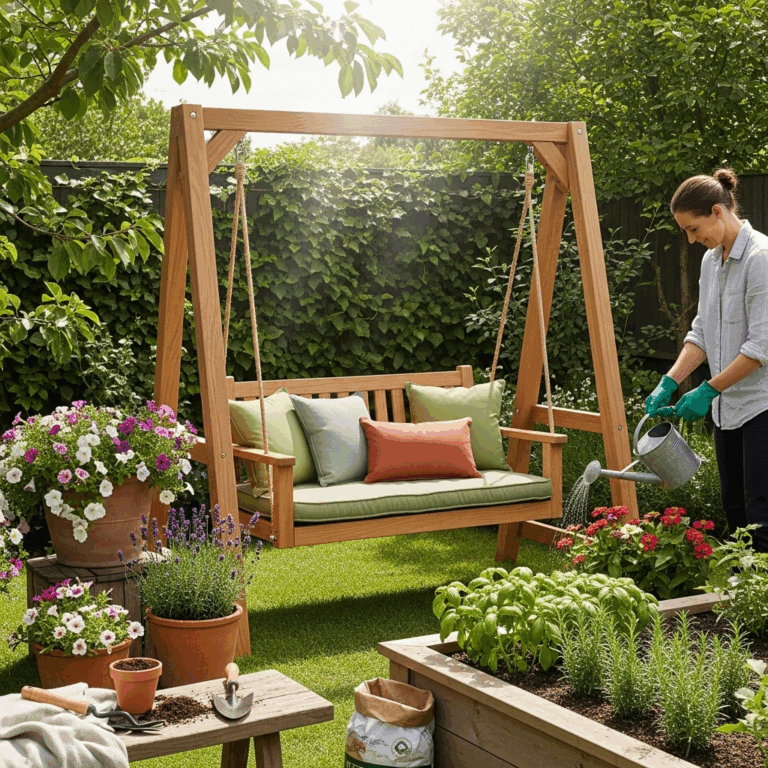To care for bamboo plants indoors, provide them with bright, indirect light, a well-draining potting mix, and consistent watering. Keep humidity levels moderate, feed them with a balanced liquid fertilizer during the growing season, and repot when root-bound. Avoid direct sun and overwatering to ensure healthy growth.
Welcome, fellow plant lovers! Are you enchanted by the graceful sway and calming presence of bamboo, wishing you could bring that serene vibe indoors? You’ve come to the right place! Many of us have been there – staring at a beautiful bamboo plant and wondering if it’s as tricky to keep alive indoors as it seems. The good news is, with a little know-how, caring for indoor bamboo is totally achievable, even if you’re just starting your green thumb journey. Let’s dive into simple, effective ways to nurture your indoor bamboo and watch it thrive!
This guide is designed to be your go-to resource, breaking down everything from sunlight needs to watering schedules into easy-to-follow steps. We’ll cover the essentials so you can confidently care for your indoor bamboo and enjoy its beauty for years to come. Get ready to transform your space with this wonderful plant!
Why Choose Indoor Bamboo?
Bamboo isn’t just for tropical gardens; certain varieties are fantastically suited for indoor life! Bringing bamboo inside offers a unique blend of aesthetic appeal and potential well-being benefits. Its striking appearance can add a touch of natural elegance to any room, from a minimalist apartment to a cozy family home. Beyond its beauty, many believe bamboo plants contribute to a Feng Shui-inspired environment, promoting harmony and positive energy flow.
For beginners, lucky bamboo (Dracaena sanderiana) is often the star of indoor bamboo displays. It’s incredibly hardy and forgiving, making it an ideal starting point. Unlike its larger, outdoor cousins, indoor bamboo varieties are typically smaller and more manageable, perfect for desks, shelves, or even bathrooms. Let’s explore what makes it such a great choice.
Benefits of Indoor Bamboo
- Aesthetic Appeal: Adds a touch of nature and sophistication to your decor.
- Air Purification: Some studies suggest plants can help improve indoor air quality.
- Feng Shui: Believed to bring good luck, prosperity, and positive energy.
- Low Maintenance: Generally forgiving and easy to care for, especially lucky bamboo.
- Space Saver: Compact varieties fit well in smaller living spaces.
Understanding Your Indoor Bamboo
Before we get into the nitty-gritty of care, it’s helpful to know a little about what kind of bamboo you likely have indoors. While many people refer to “lucky bamboo,” it’s important to note that this is not true bamboo (Bambusoideae subfamily). Instead, it’s a type of Dracaena, specifically Dracaena sanderiana. This distinction is key because its care requirements differ slightly from true bamboos.
True bamboos can also be grown as houseplants, but they usually require more space and specific conditions. For the purpose of this guide, we’ll focus primarily on the care of the most common indoor variety, lucky bamboo, while touching upon general principles that can benefit other indoor bamboo-like plants.
Lucky Bamboo vs. True Bamboo
| Feature | Lucky Bamboo (Dracaena sanderiana) | True Bamboo (Bambusoideae) |
|---|---|---|
| Botanical Family | Asparagaceae (Asparagus family) | Poaceae (Grass family) |
| Growth Habit | Slow-growing, stalk-like; often sold with aerial roots. | Fast-growing, can become large; spreads via rhizomes. |
| Watering Needs | Prefers consistently moist soil or clean water; sensitive to chlorine. | Needs well-draining soil and consistent moisture; some varieties tolerate drier conditions. |
| Light Needs | Bright, indirect light; can tolerate lower light but may become leggy. | Varies by species, but generally bright, indirect light. |
| Container Size | Small pots or decorative containers; can also grow in water. | Requires large pots or a dedicated garden space due to extensive root systems. |
Essential Care Components
Now, let’s get down to the essential elements for keeping your indoor bamboo happy and healthy. Think of these as the building blocks for a thriving plant!
1. Light: Finding the Sweet Spot
Light is crucial for any plant, and bamboo is no exception. Most indoor bamboo, especially lucky bamboo, craves bright, indirect light. This means a spot near a window where the sun doesn’t beat down directly for extended periods. Think of a spot that receives morning sun but is shaded from the harsh afternoon rays.
Too much direct sun can scorch the leaves, causing them to turn yellow or brown. On the flip side, too little light might cause your plant to become leggy, with long, weak stems and sparse foliage, as it stretches to find light. A lightly shaded east-facing window or a spot a few feet away from a south or west-facing window is often ideal.
If natural light is scarce in your home, don’t fret! You can supplement with a grow light. Many affordable LED grow lights are available, providing the spectrum of light plants need. Aim to keep the light on for about 10-12 hours a day, mimicking a natural day-night cycle.
2. Watering: The Art of Hydration
Watering is perhaps the most critical aspect of bamboo care. Overwatering is a common pitfall for many houseplants, and bamboo can be sensitive to it. The goal is to keep the soil consistently moist but not waterlogged.
If your bamboo is planted in soil:
- Check the soil moisture regularly. Stick your finger about an inch or two into the soil. If it feels dry, it’s time to water.
- Water thoroughly until you see water draining from the bottom of the pot. This ensures the entire root ball gets hydrated.
- Discard any excess water that collects in the saucer. Letting the plant sit in water can lead to root rot.
- Use filtered, distilled, or rainwater whenever possible. Tap water often contains chlorine and fluoride, which can build up in the soil and harm your bamboo, especially lucky bamboo. If you must use tap water, let it sit out for 24 hours to allow some of the chemicals to dissipate.
If your bamboo is growing in water (common for lucky bamboo):
- Use only clean, filtered, distilled, or rainwater.
- Change the water completely every 1-2 weeks. This prevents the buildup of bacteria and ensures the roots have access to fresh oxygen.
- Ensure the roots are fully submerged.
- If you notice algae forming in the container, clean it thoroughly during the water change.
3. Soil and Potting: A Foundation for Growth
While lucky bamboo can grow in just water, most other indoor bamboo varieties will need soil. Choosing the right potting mix is important for drainage and aeration, preventing root rot.
For potted indoor bamboo:
- Potting Mix: Opt for a well-draining potting mix. A standard houseplant mix amended with perlite or orchid bark works well. You can also create your own by mixing equal parts potting soil, peat moss, and perlite. A good mix should feel light and airy, allowing water to flow through easily.
- Drainage Holes: Always use pots with drainage holes. This is non-negotiable for preventing waterlogged roots. Terra cotta pots can also be beneficial as they allow the soil to breathe and dry out more evenly.
- Container Size: Start with a container that is only slightly larger than the root ball. As your bamboo grows, you’ll need to repot it into a larger container.
4. Humidity: Mimicking Natural Environments
Bamboo plants generally appreciate a bit of humidity. Indoor environments, especially those with central heating or air conditioning, can be quite dry. This can lead to brown leaf tips or stunted growth.
Here are some ways to boost humidity around your bamboo:
- Misting: Lightly misting the leaves with water a few times a week can help. Use filtered or distilled water to avoid mineral deposits on the leaves.
- Pebble Tray: Place the pot on a tray filled with pebbles and water. As the water evaporates, it creates a more humid microclimate around the plant. Ensure the bottom of the pot isn’t sitting directly in the water.
- Grouping Plants: Placing your bamboo among other houseplants can also increase local humidity.
- Humidifier: For a more significant impact, especially in very dry climates, consider using a small room humidifier near your plants.
5. Temperature: Comfortable Climates
Indoor bamboo plants are generally content with the average temperatures found in most homes. They thrive in temperatures between 65°F and 75°F (18°C to 24°C). Avoid placing them near heating vents, radiators, or drafty windows, as sudden temperature fluctuations can stress the plant.
6. Fertilizing: A Little Boost
Bamboo doesn’t require heavy feeding, but a little nourishment during the growing season can encourage robust growth. The growing season typically spans from spring through summer.
For potted bamboo:
- Use a balanced liquid houseplant fertilizer diluted to half strength.
- Fertilize once a month during the spring and summer months.
- Avoid fertilizing during the fall and winter, when the plant’s growth naturally slows down.
- If your lucky bamboo is in water, you can use very dilute liquid fertilizer specifically for lucky bamboo, or add a tiny amount of hydroponic nutrient solution. Be cautious, as over-fertilizing can be harmful.
7. Pruning and Maintenance: Keeping it Tidy
Pruning your indoor bamboo is mostly about aesthetics and managing its size. If your plant gets too tall or leggy, you can simply prune it back.
- Trimming Stems: Use clean, sharp scissors or pruning shears to cut stems to your desired height. New shoots will often emerge from just below the cut.
- Removing Yellow or Brown Leaves: Trim away any discolored or dead leaves with clean scissors. This helps the plant direct energy to healthy growth and also keeps it looking tidy.
8. Repotting: Giving it Room to Grow
Bamboo plants, especially true bamboos, can grow quite vigorously. Eventually, they will outgrow their current pot. Signs that it’s time to repot include roots growing out of the drainage holes, the plant drying out very quickly, or stunted growth.
When to repot:
- Repot every 2-3 years, or when you notice it’s becoming root-bound.
- The best time to repot is in the spring, at the beginning of the growing season.
How to repot:
- Choose a pot that is 2-4 inches larger in diameter than the current pot. Ensure it has drainage holes.
- Gently remove the bamboo plant from its current pot. If it’s stuck, you can gently tap the sides of the pot or run a knife around the edge.
- Inspect the roots. Trim away any dead or mushy roots.
- Place a layer of fresh, well-draining potting mix in the new pot.
- Position the bamboo plant in the new pot so the top of the root ball is about an inch below the rim.
- Fill the rest of the pot with fresh potting mix, gently firming it around the roots.
- Water the plant thoroughly.
Common Issues and How to Solve Them
Even with the best care, you might encounter a few common problems. Don’t get discouraged; these are usually easy to fix!
1. Yellowing Leaves
- Cause: Overwatering is the most frequent culprit. It can also be caused by underwatering, lack of nutrients, or shock from sudden environmental changes. For lucky bamboo in water, it could be due to chemicals in the tap water.
- Solution: Check your watering habits and adjust. Ensure the pot has good drainage. If using tap water for lucky bamboo, switch to filtered or distilled water. If the problem persists, consider a light feeding if it’s been a while.
2. Brown Leaf Tips
Cause: This is often a sign of low humidity or mineral buildup from tap water. Burning from too much direct sunlight can also cause this.
Solution: Increase humidity using one of the methods mentioned earlier. Switch to filtered water. Ensure the plant isn’t getting direct, harsh sunlight.
3. Leggy Growth
Cause: Insufficient light is the primary reason. The plant is stretching to find more light.
Solution: Move your bamboo to a brighter location with indirect light. If natural light is limited, consider supplementing with a grow light. Pruning can also help encourage bushier growth.
4. Pests
Cause: While not common, indoor bamboo can occasionally attract common houseplant pests like spider mites or mealybugs.
Solution: Inspect your plant regularly. If you find pests, isolate the plant to prevent spreading. Wipe the leaves with a damp cloth or use a cotton swab dipped in rubbing alcohol to remove them. For more stubborn infestations, horticultural soap or neem oil can be effective. You can find helpful resources on identifying and treating common houseplant pests from reputable sources like the University of California Integrated Pest Management Program.
Bamboo Plant Symbolism and Feng Shui
The appeal of lucky bamboo extends beyond its aesthetic. In Feng Shui, bamboo is highly regarded for its positive attributes:
- Resilience: Its ability to grow quickly and bend without breaking symbolizes flexibility and strength.
- Growth and Prosperity: Often associated with wealth, good fortune, and success.
- Balance: The number of stalks can also hold significance. For example, five stalks are said to represent balance in the five elements (wood, fire, earth, metal, water).
Placing lucky bamboo in specific areas of your home or office, such as the wealth corner (often the far-left corner of a room from the entrance) or a work-related space, is believed to enhance these positive energies.
Choosing the Right Pot for Your Bamboo
The pot your bamboo resides in plays a role in its health and appearance. While lucky bamboo often comes in decorative glass vases or ceramic containers, remember that true bamboos will need more robust pots.
| Pot Type | Pros | Cons | Best For |
|---|---|---|---|
| Ceramic/Terracotta | Porous (terracotta) allows soil to breathe, preventing overwatering. Heavy and stable. | Can be heavy. Terracotta dries out faster. Might not have drainage if decorative. | Potted lucky bamboo and true bamboo varieties. |
| Plastic | Lightweight, inexpensive, retains moisture well. | Less breathable, can contribute to overwatering if not careful. | Beginners, especially with true bamboo varieties that like consistent moisture. |
| Glass Vases | Visually appealing, easy to see root development and water levels. | No drainage, easy to overwater, can promote algae growth, roots get direct light. | Primarily for lucky bamboo grown hydroponically (in water). |
| Self-Watering Pots | Reduce watering frequency, provide consistent moisture. | Can be more expensive, may not suit all plant needs. | Busy plant owners, or those prone to forgetting to water. |
Troubleshooting Common Issues with Frequencies
Understanding the frequency of certain care tasks can help prevent problems before they start. Here’s a quick reference guide:
| Care Task | Lucky Bamboo (Water) | Potted Bamboo (Soil) | Frequency |
|---|---|---|---|
| Water Change/Watering | 1-2 weeks | When top inch of soil is dry (approx. 1-2 weeks) |






